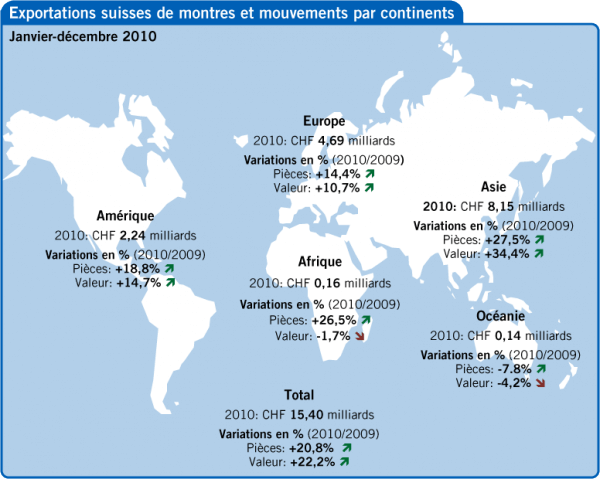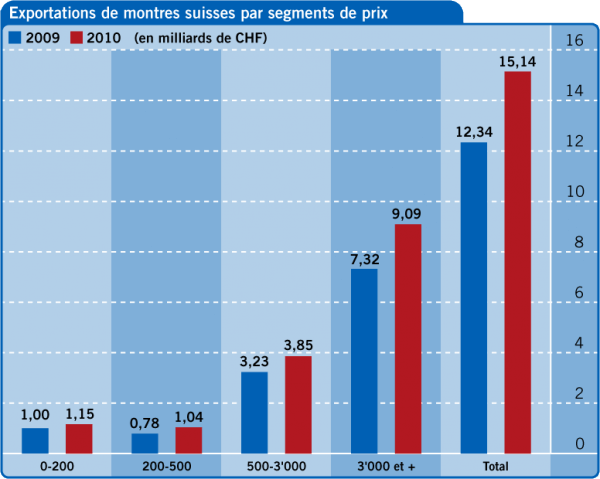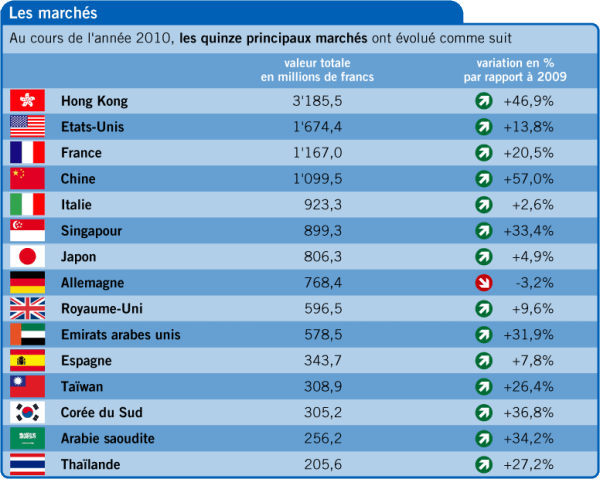After a buoyant start to the third quarter 2010, the rise in Swiss watch exports stayed strong through December, climbing 25.8% and bringing annual growth compared to the previous year to 22.1%. While the sting hasn’t completely subsided, the “black hole” of 2009 is now history. With exports of wristwatches posting a value of CHF 15.1 billion in 2010, the segment is hot on the heels of the CHF 15.8 billion that made 2008 a record year. As a reminder, exports of wristwatches plummeted to CHF 12.3 billion in 2009. Given the favourable outlook for the current twelve months, based on early indications from the branch, 2011 might well set a new record. An increase of 5% is all it would take to equal results of two years ago. And companies are expecting much more than that.

The shift towards Asia
Closer analysis reveals that exports of watches having an ex-works price above CHF 1,500 (8% of export volumes / 74% of value) grew higher than average last year, particularly in price ranges of CHF 3,000 to CHF 6,000. Beyond this point, growth was slightly impaired by production backlogs. Granted, these figures are for watches leaving Switzerland, not sales to end customers. However, given the scale of inventory drawdown during 2009 they are, in all probability, an accurate reflection of the market.
Turning to the markets, the number-one destination for Swiss watch exports is clearly Asia which (including Japan) accounted for 44.2% of total export value in 2010. Add to this purchases made by Asian customers travelling abroad (where duty is lower) and it’s easy to understand why every other Swiss watch buyer is of Asian origin. This is also the region that posted strongest growth in 2010 (+37%) and the only one, excluding the EFTA countries of Iceland, Liechtenstein, Norway and Switzerland, to have outperformed (+12%) its 2008 high level.

The parry against a strong franc
Two factors, both difficult to evaluate, weigh on this spectacular progress: exchange rates and the cost of metal. With gold and platinum prices spiralling 26.4% and 24.5% respectively in one year, and the Swiss franc gaining almost 16% on the Euro and close to 10% against the US Dollar over the same period, brands will be hard-pressed to maintain margins without a price hike. Analysts at Vontobel Bank are in no doubt that exchange rates will be the sector’s biggest concern over the coming months. This wasn’t, however, an obstacle to growth for the Swatch Group, as it reports in its key figures for 2010: “Despite significant currency losses, net income rose to a record level of CHF 1,080 million, an increase of 41.5% on 2009.”
In a recent newsletter to small and medium enterprises, Credit Suisse notes that “the Swiss export sector has proved in the past that it is able to cope with a strong currency. In periods when the currency was strong, Switzerland was constantly forced to seek out efficiency gains and improve productivity, as well as launch innovative products on the market. Exporters also have financial hedging opportunities in the short term. In the long term, however, they will look to “natural hedging” – meaning they will endeavour to ensure more of their costs are incurred in foreign currencies. Another key factor is that a large number of exporters are defined by the high quality of their products, and are therefore less strongly exposed to price competition.” Preserving the subtle balance between supply and demand on markets with a strong currency should also help keep the problem in check, and even contribute to re-exports by taking advantage of favourable exchange rates. No doubt this is another area where watchmaking will put its legendary inventiveness to good use.











